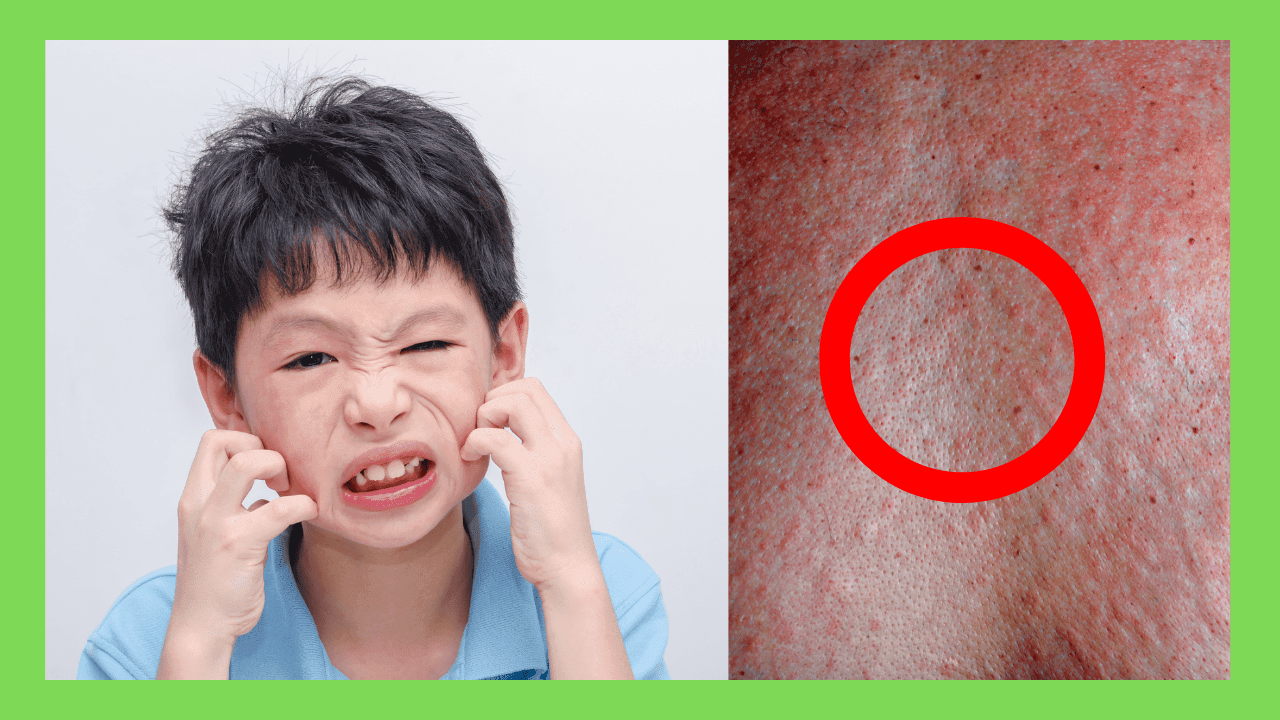Here’s an overview:
Introduction to Skin Rashes in Children
Skin rashes in children are common and can arise from various causes. Recognizing the specific type of rash is crucial for effective treatment. Rashes can appear in different forms, such as red, itchy patches or blisters. Key factors include:
- Infections: Viral, bacterial, or fungal infections.
- Allergies: Reactions to foods, medications, or environmental allergens.
- Heat: Prickly heat from excessive sweating.
- Irritants: Contact with harsh chemicals or fabrics.
Health professionals often require a detailed history and physical examination to diagnose the cause accurately. Treatment options range from topical ointments to oral medications, depending on the root cause.
Common Types of Skin Rashes in Children
1. Diaper Rash
Diaper rash is a common inflammatory skin condition that develops in the diaper-covered region. It often results from prolonged exposure to wet or soiled diapers, causing red, tender skin.
2. Eczema
Eczema, or atopic dermatitis, presents as red, itchy patches on the skin. It commonly affects the cheeks, arms, and legs. Triggers include allergens, temperature changes, and irritants.
3. Chickenpox
Chickenpox causes an itchy, blister-like rash that appears in waves. It is highly contagious and spreads through direct contact or respiratory droplets.
4. Measles
Measles features a red, blotchy rash starting on the face and spreading downward. It is accompanied by fever, cough, and conjunctivitis.
Identifying Symptoms of Skin Rashes
Parents and caregivers should be vigilant in monitoring various symptoms that indicate skin rashes in children. Key signs to look for include:
- Redness: Widespread or localized redness on the skin.
- Swelling: Noticeable swelling in the affected area.
- Itchiness: Persistent itching that causes discomfort.
- Blisters: Formation of fluid-filled blisters or bumps.
- Scaling: Dry, flaky patches or cracked skin.
- Pain: Sensitivity or tenderness to touch.
- Fever: Accompanied fever or general malaise.
- Oozing: Discharge of fluid or pus from the rash.
- Crusting: Development of crusty layers over the rash.
- Spreading: Rapid spread of the rash to other areas.
Causes of Skin Rashes in Children
Skin rashes in children can result from a variety of factors. Recognizing the underlying cause is crucial for effective treatment. Below are some common causes:
- Allergies: Food, pollen, or pet dander can trigger allergic reactions, resulting in rashes.
- Infections: Bacterial, viral, and fungal infections can manifest as skin rashes.
- Eczema: A chronic condition causing dry, flaky skin which often leads to rashes.
- Heat Rash: Excessive sweating causes blocked sweat ducts, leading to red bumps.
- Diaper Rash: Prolonged exposure to wet diapers causes irritation.
- Contact Dermatitis: Direct skin contact with irritants or allergens.
- Insect Bites: Bug bites can cause localized skin reactions.
Understanding these causes helps guide appropriate medical intervention.
Allergic Reactions Leading to Rashes
Allergic reactions are a common source of rashes in children. These reactions can stem from various allergens such as foods, insect stings, medications, or environmental factors.
- Foods: Common food allergens include peanuts, eggs, and dairy products.
- Insect Stings: Bee or wasp stings can cause localized swelling and rashes.
- Medications: Antibiotics and other medications may lead to hives or other skin reactions.
- Environmental Factors: Pollen, pet dander, and dust mites are frequent culprits.
Symptoms typically include redness, itching, and swelling. Immediate medical attention is essential if breathing difficulties or widespread rashes occur.
Infectious Causes of Skin Rashes
Certain infections can cause skin rashes in children. These include:
- Viral Infections: Viruses like measles, chickenpox, and Fifth disease often result in rashes. Measles appears as red spots starting on the face.
- Bacterial Infections: Bacteria such as Streptococcus can cause impetigo, presenting as red sores around the mouth and nose.
- Fungal Infections: Ringworm manifests as a ring-shaped, scaly rash.
- Parasitic Infections: Scabies, caused by mites, leads to itchy, pimple-like rashes.
Understanding these causes aids healthcare providers in diagnosing and recommending appropriate treatments swiftly.
Non-Infectious Causes of Skin Rashes
Non-infectious causes of skin rashes in children can arise from various sources. Key factors include:
- Allergic Reactions: Caused by exposure to allergens like foods, pollen, or medications, leading to conditions like atopic dermatitis.
- Heat: Excessive sweating can block sweat ducts, resulting in heat rashes, also known as miliaria.
- Autoimmune Disorders: Conditions like psoriasis can cause red, scaly patches on the skin.
- Genetic Factors: Some children may inherit skin conditions like eczema from their parents.
- Environmental Irritants: Contact with irritants such as soaps, detergents, or fabrics can trigger rash.
Accurate diagnosis often requires consultation with a dermatologist.
When to Consult a Pediatrician
Consulting a pediatrician is essential in the following scenarios:
- Rashes that persist beyond a few days without improvement
- Accompanied by a high fever or other symptoms like fatigue or breathing difficulties
- If the rash appears suddenly and spreads quickly
- When there is severe pain, swelling, or the rash is developing blisters or pus
- Any changes in behavior or mood, such as irritability or confusion, alongside the rash
- The rash covers a significant portion of the body or involves sensitive areas like the face or genitals
- If over-the-counter treatments do not alleviate the rash
Over-the-Counter Treatments and Home Remedies
Treating skin rashes in children often begins with over-the-counter solutions and home remedies. Parents and caregivers may consider the following options:
- Topical Creams and Ointments:
- Hydrocortisone cream
- Calamine lotion
- Oral Antihistamines:
- Diphenhydramine
- Cetirizine
- Moisturizers and Emollients:
- Fragrance-free lotions
- Petroleum jelly
Home remedies can be equally effective. Suggestions include:
- Oatmeal Baths: Soothes itchy skin.
- Cool Compresses: Reduces inflammation.
- Herbal Applications: Chamomile or calendula infusions applied topically.
Parents should consult a healthcare professional if symptoms persist.
Prescription Treatments and Medical Interventions
Several prescription treatments and medical interventions may be necessary for severe or persistent skin rashes in children.
- Topical corticosteroids: Often prescribed to reduce inflammation and itching.
- Antihistamines: Used to alleviate allergic reactions and associated symptoms.
- Antibiotics: Required for bacterial infections presenting as rashes.
- Antiviral medications: Needed if the rash is due to viral infections like herpes.
- Immunosuppressants: Used in severe cases of eczema or psoriasis.
- Moisturizers and emollients: Recommended for ongoing skin hydration and barrier repair.
- Specialized treatments: Required for conditions like impetigo or scabies.
Preventive Measures for Reducing Skin Rashes
Maintaining proper skin hygiene is essential to prevent skin rashes in children. Parents should:
- Bathe children regularly with mild, fragrance-free soaps.
- Keep their skin moisturized to prevent dryness.
- Choose clothing made from soft, breathable fabrics like cotton.
- Change diapers frequently to prevent diaper rash.
- Educate children to avoid scratching and provide soft mittens for infants.
For children prone to allergies or eczema, minimizing exposure to allergens such as pollen, pet dander, and certain foods is crucial. Additionally, ensuring a balanced diet rich in vitamins and minerals can boost skin health.
Managing Chronic Skin Conditions
Chronic skin conditions in children can be challenging. Effective management involves:
- Regular Monitoring: Frequent check-ups with a dermatologist.
- Medication: Prescribed topical or oral treatments to reduce symptoms.
- Skin Care Routine: Use of gentle cleansers and moisturizers to avoid irritation.
- Diet and Nutrition: Ensuring a balanced diet to support skin health.
- Allergen Management: Identifying and avoiding potential allergens.
Parents play a crucial role in adherence to treatment plans, ensuring their child follows skincare routines, and attending regular medical appointments. Continuous education on triggers and symptoms updates caretakers on best practices.
Impact of Diet and Lifestyle on Skin Health
Diet and lifestyle exert significant influence on children’s skin health. Proper hydration and nourishment are paramount.
- Hydration: Adequate intake of water helps maintain skin hydration, reducing dryness and irritation.
- Nutrition: A balanced diet rich in vitamins and minerals supports skin immunity and cell repair.
- Vitamin A: Promotes skin repair.
- Vitamin C: Enhances collagen production.
- Zinc: Assists in skin healing.
- Hygiene: Regular, gentle cleansing prevents the buildup of dirt and bacteria, mitigating rash risks.
- Physical Activity: Regular exercise improves blood circulation, nourishing skin cells.
Unhealthy diets and sedentary lifestyles can exacerbate skin issues.
Understanding the Role of Hygiene
Proper hygiene is crucial in preventing skin rashes in children. Regular bathing using mild soap removes dirt, bacteria, and allergens. Consistent handwashing minimizes germ transmission and potential skin irritants. Clean clothing, laundered with hypoallergenic detergents, can reduce allergic reactions. Trimmed nails hinder scratching, which may exacerbate rashes.
Key Hygiene Practices:
- Regular Bathing: Use warm water and gentle, fragrance-free soaps.
- Clothing: Wash clothes with gentle, fragrance-free detergent.
- Handwashing: Encourage frequent hand washing using mild soap.
- Nail Care: Keep nails short and clean to prevent skin damage.
These practices help maintain healthy skin, mitigating rash occurrence.
Emotional and Psychological Aspects of Skin Rashes
Children often experience discomfort and distress from skin rashes. The itching and irritation can cause them to become anxious, leading to sleep disturbances.
Common Emotional Reactions:
- Irritability due to persistent itching.
- Embarrassment about visible rashes.
- Frustration from parental interventions.
Parents’ Emotional Responses:
- Worry about the severity and duration of the rash.
- Stress from managing treatments.
Effective communication between healthcare providers, children, and parents is essential. Emotional support and reassurance can play a crucial role in coping with the psychological impact of skin rashes.
Case Studies: Real-Life Examples
Case Study 1: Eczema
- Patient: 4-year-old female
- Symptoms: Red, itchy patches on elbows and knees
- Diagnosis: Atopic dermatitis
- Treatment: Emollients and topical corticosteroids
- Outcome: Significant improvement within two weeks
Case Study 2: Ringworm
- Patient: 7-year-old male
- Symptoms: Circular, scaly rashes on arm
- Diagnosis: Tinea corporis
- Treatment: Antifungal cream application
- Outcome: Rash resolved after four weeks
Case Study 3: Chickenpox
- Patient: 6-year-old female
- Symptoms: Itchy blisters on body
- Diagnosis: Varicella-zoster virus
- Treatment: Antihistamines for itching, calamine lotion
- Outcome: Full recovery; rashes healed within two weeks
Conclusion: Ensuring Healthy Skin for Children
To promote and maintain healthy skin in children, a proactive approach is necessary.
- Identify Allergens: Regularly monitor and eliminate known allergens from the child’s environment.
- Proper Hygiene: Encourage consistent hand washing and bathing to prevent infections.
- Moisturization: Apply child-friendly moisturizers to keep the skin hydrated.
- Balanced Diet: Ensure a diet rich in vitamins and minerals to support skin health.
- Sun Protection: Use appropriate sunscreen to protect against harmful UV rays.
By adhering to these guidelines, parents can foster resilient and healthy skin in their children.

